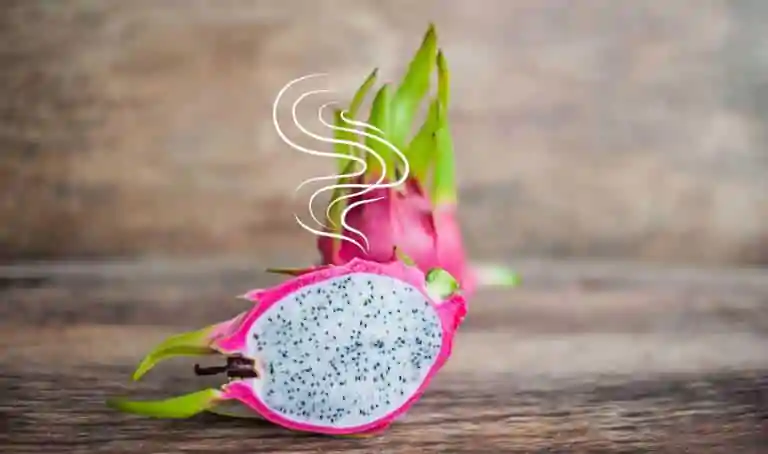Dragon fruit, known for its shiny appearance and delightful taste, can be a delightful addition to your culinary repertoire. To fully enjoy its unique flavour, it’s crucial to understand how to discern the signs of freshness and the same is the case with all citrus fruits.
In this comprehensive guide, we’ll explore the various aspects of determining whether a dragon fruit has gone bad. Here is what you can do.
Tips to See if the Dragon Fruit Has Gone Bad
Make sure you follow these tips to get an idea if your dragon fruit has gone bad.
Visual Inspection
When you first see a dragon fruit, look at its outside to know if it’s fresh. A good dragon fruit has a bright and even colour. If you see dark spots or patches, it might mean the fruit got bruised or is starting to go bad. Touch the skin gently; it should feel firm without any wrinkles, which could mean the fruit is drying out.
After checking how it looks, use your fingers to feel the fruit. A fresh dragon fruit will be firm and not squishy. Its skin should be smooth, not wrinkled. If it feels bumpy or soft, it might not be fresh. This touch test helps you make sure the fruit is full of juice and flavor. So, when picking a dragon fruit, pay attention to both how it looks and how it feels to make sure it’s fresh and tasty.
Texture Matters
Touching the fruit is a crucial step in the assessment process. Gently press the dragon fruit; it should yield slightly but maintain an overall firmness. If it feels mushy or overly soft, it may be overripe or worse, spoiled. Unusual textures, such as sliminess or excessive dryness, should raise red flags.
Gently press the fruit, and it should be a little soft but still hold its shape. If it feels too mushy or super soft, that’s a sign it might be too ripe or even not good anymore.
Also, pay attention to how it feels. If it’s slimy or too dry. Sliminess could mean there’s something growing on it, and too much dryness might mean it’s not juicy inside
The Scent Test
A fresh dragon fruit emits a subtle, sweet aroma. If the scent is sour, fermented, or generally unpleasant, it’s likely past its prime. Ensure that the fragrance is consistent throughout the fruit; any foul odours may suggest bacterial or fungal growth.
A fresh dragon fruit should have a subtle and sweet smell that makes you look forward to taking a bite. However, if that scent turns sour, like old milk, or starts to smell a bit off, it’s a sign the fruit might not be at its best.
Take a moment to check if the smell is the same all over the fruit. If you notice any foul or weird smells in certain areas then these strange odors can be a sign of bacteria or fungus, which means the dragon fruit may not be safe to eat. So, by trusting your nose and making sure the sweet aroma is everywhere, you’re giving yourself a good chance to enjoy a delicious and fresh dragon fruit.
Unveiling the Flesh
Cutting into the dragon fruit reveals its inner world. The flesh should be white or red, depending on the variety, with small, black seeds evenly distributed. Any brown discoloration or off-color patches are indicators of spoilage. If the flesh has turned dark or grey, it’s no longer fit for consumption.
Seeds Speak Volumes
Healthy dragon fruit seeds are typically black and crunchy. If the seeds appear discoloured, mouldy, or soft, it’s a clear sign that the fruit may have gone bad.
In a healthy dragon fruit, these seeds are usually black and make a satisfying crunch when you bite into them. When the seeds are black and crunchy, it’s a sign that the fruit is in good shape and ready to be enjoyed.
However, if you notice the seeds are a different color – maybe they look discolored, moldy, or feel soft when you bite into them then it’s a warning. These changes in the seeds indicate that something might be going wrong inside the fruit. So, paying attention to the seeds will help you decide if it’s still good to eat or if it’s time to pick another one.
Mold and Unwanted Growth:
Inspect the entire surface of the fruit for any visible signs of mold or unusual growth. Mold can manifest on both the skin and the flesh, rendering the fruit unsafe to eat.
The Taste Test
When in doubt, trust your taste buds. Fresh dragon fruit has a mildly sweet flavor. Any bitterness, sourness, or off-taste could mean it’s past its prime. Also, if you happen to have any issues with taste buds, get to know how to get rid of them.
Considering Storage Conditions:
Evaluate how the dragon fruit has been stored. Exposure to extreme temperatures or improper storage can hasten spoilage. If the fruit has been kept in overly humid conditions, mold growth is more likely.
Ensuring the freshness of dragon fruit involves a multi-faceted assessment. By considering its visual appearance, texture, aroma, inner flesh, seeds, and storage conditions, you can confidently determine whether this exotic fruit is ready for your table. Remember, a well-preserved dragon fruit is not just a feast for the eyes but a delight for the taste buds.


